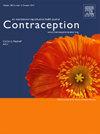Assessing the impact of federal restrictions to the Title X program on reproductive health service provision between 2018 and 2022 in the United States
IF 2.3
2区 医学
Q1 OBSTETRICS & GYNECOLOGY
引用次数: 0
Abstract
Objectives
In 2019, the Trump administration introduced rule changes, colloquially known as the “Domestic Gag Rule,” to the federal Title X program. As a result, many grantees withdrew from the program. This study aims to assess the impact of the rule change on service provision within the Title X program, both while the rule was in place and in the period following its reversal.
Study design
We obtained disaggregated Family Planning Annual Report data for all states from 2018 to 2022. Using a previously created variable determining the proportion of each state’s Title X capacity loss from the 2019 rule (0%, 1–24%, 25–50%, 50–89%, 90–99%, 100%), we conducted mixed effects linear regression exploring outcomes of interest (number of total clients served; number of female/male contraceptive methods provided; contraceptive method mix; sexually transmitted infection [STI] services provided) prerule change (2018), during the rule change (2019–2021), and postrule change (2022).
Results
During the rule change period, the average total number of services Title X provided decreased by 16% nationwide from the prerule change period. However, states with higher levels of reduced capacity saw significant additional losses in reproductive health service provision. The total number of clients, the number of female/male contraceptive methods, and the number of STI services provided did not improve in the postrule change period. In addition, the number of moderately effective methods provided decreased significantly during the rule change period and continued to decline postrule change.
Conclusions
Title X services were significantly impacted by the rule change, and subsequent recovery is slow.
Implications
During the 2019–2021 Title X rule change, there was a nationwide decrease in reproductive health services provided (contraceptive services, STI testing) through Title X. States with higher capacity loss had a more significant decline. Postrule change, service levels did not return to prerule change levels, indicating a slow recovery.
评估 2018-2022 年间联邦限制第十章计划对美国提供生殖健康服务的影响。
目标:2019 年,特朗普政府对联邦第十章计划进行了规则修改,俗称 "国内禁言规则"。因此,许多受赠方退出了该计划。本研究旨在评估规则变更对第十章计划内服务提供的影响,包括规则实施期间和规则撤销后的时期:我们获得了 2018-2022 年所有州的计划生育年度报告分类数据。利用之前创建的变量来确定各州因 2019 年规则而损失的 Title X 容量比例(0%、1-24%、25-50%、50-89%、90-99%、100%),我们对规则变更前(2018 年)、规则变更期间(2019-2021 年)和规则变更后(2022 年)的相关结果(服务的客户总数、提供的女性/男性避孕方法数量、避孕方法组合、提供的性传播感染(STI)服务)进行了混合效应线性回归:结果:在规则变更期间,全国范围内 Title X 所提供服务的平均总数比规则变更前减少了 16%。然而,在能力缩减程度较高的州,生殖健康服务的提供出现了显著的额外损失。在规则修改后,服务对象总数、女性/男性避孕方法数量以及性传播感染服务数量都没有得到改善。此外,在规则修改期间,所提供的中度有效避孕方法的数量大幅下降,规则修改后继续下降:结论:第 X 篇的服务受到规则变更的严重影响,其后恢复缓慢。
本文章由计算机程序翻译,如有差异,请以英文原文为准。
求助全文
约1分钟内获得全文
求助全文
来源期刊

Contraception
医学-妇产科学
CiteScore
4.70
自引率
17.20%
发文量
211
审稿时长
69 days
期刊介绍:
Contraception has an open access mirror journal Contraception: X, sharing the same aims and scope, editorial team, submission system and rigorous peer review.
The journal Contraception wishes to advance reproductive health through the rapid publication of the best and most interesting new scholarship regarding contraception and related fields such as abortion. The journal welcomes manuscripts from investigators working in the laboratory, clinical and social sciences, as well as public health and health professions education.
 求助内容:
求助内容: 应助结果提醒方式:
应助结果提醒方式:


